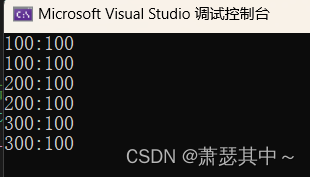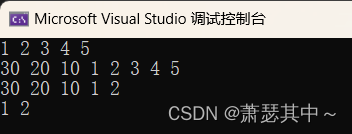目录
前言
1. list的简介
2.list讲解和模拟实现
2.1 默认构造函数和push_back函数
2.2 迭代器实现
2.2.1 非const正向迭代器
2.2.2 const正向迭代器
2.2.3 反向迭代器
2.3 插入删除函数
2.3.1 insert和erase
2.3.2 push_back pop_back push_front pop_front
2.4 构造函数,赋值拷贝函数,析构函数
总结
前言
这篇文章讲述常用容器list的使用和一些重要部分的简单模拟实现,仅仅只是了解一些实现方法。内容丰富,干货多多。
1. list的简介
- list是序列容器,允许在序列内的任何位置进行常量时间的插入和删除操作,以及两个方向的迭代。
- 列表容器被实现为双链表;双链表中每个元素存储在互不相关的几点钟,在节点中通过指针指向其前一个元素和后一个元素。
- 它们与forward_list非常相似:主要区别在于forward_list对象是单链表,因此它们只能向前迭代,让其更简单高效。
- 与其他基本标准序列容器(array、vector和deque)相比,列表在容器内的任何位置插入、提取和移动元素方面通常表现更好。
- 与其他序列容器相比,列表和forward_lists的主要缺点是它们无法通过位置直接访问元素;例如,要访问列表中的第八个元素,必须从已知位置(如开始或结束)迭代到该位置,这需要在两者之间的距离上花费线性时间。它们还消耗一些额外的内存来保存与每个元素相关联的链接信息(对于包含小元素的大型列表来说,这可能是一个重要因素)。
- 下面是展示list类的内部成员变量结构,并且之后要简单模拟实现,所以加上一个命名空间,防止与库中list起冲突。
- list即是双向链表结构,我们使用模版定义一个ListNode类,内部成员变量有两个指针,指向前一个元素和后一个元素,还有存储T类型的元素。在list类中,我们可以使用typedef简化LIstNode<T>成Node。Node类型的指针变量_head,代表第一个哨兵位结点,不存放元素。
- 其中ListNode使用struct而不用class,因为struct默认权限是公有的,且ListNode类里面的所有内容list都会使用到,所以直接用struct定义这个类。
namespace User
{template<class T>struct ListNode{ListNode*<T> _next;ListNode*<T> _prev;T _data;//...};template<class T>class list{typedef ListNode<T> Node; //...private:Node* _head;};
}2.list讲解和模拟实现
2.1 默认构造函数和push_back函数
默认构造函数构造一个只含有哨兵位结点的链表,并且哨兵位结点的的两个指针指向自身。我们暂时使用库里的list,先创建一个int类型的list容器,调用的是默认构造函数,之后尾插几个整数。遍历整个链表一般使用迭代器,还可以使用范围for。因为物理结构是不连续的,不支持使用下标方括号遍历链表。
list();//默认构造函数void test_list1()
{std::list<int> lt1;lt1.push_back(1);lt1.push_back(2);lt1.push_back(3);lt1.push_back(4);list<int>::iterator it1 = lt1.begin();while (it1 != lt1.end()){cout << *it1 << " ";++it1;}cout << endl;for (const auto& e : lt1){cout << e << " ";}cout << endl;
}运行结果如下:

- 实现一个list的默认构造函数,使用new动态开辟一个Node类型元素的内存空间,传入一个T类型的值调用LIstNode类的构造函数。下面写的是T()表示如果是自定义类型,就调用该自定义类型的构造函数,如果是内置类型,会初始化一个该类型的值,整型一般初始化为0。
- 既然list构造函数中调用了LIstNode类的构造函数,LIstNode的构造函数也需要实现。构造函数的参数是const修饰的T类型引用的data变量,顺便给上一个缺省值T(),跟上面的用法相同。
- push_back函数先动态开辟一个新结点,传入x初始化。然后再改变结点指向的位置即可。
template<class T>
struct ListNode
{ListNode*<T> _next;ListNode*<T> _prev;T _data;ListNode(const T& data = T()):_next(nullptr),_prev(nullptr),_data(data){}
};template<class T>
class list
{typedef ListNode<T> Node;
public:list(){_head = new Node(T());_head->_next = _head;_head->_prev = _head;}void push_back(const T& x){Node* newnode = new Node(x);Node* tail = _head->_prev;// head tail newnodetail->_next = newnode;newnode->_prev = tail;newnode->_next = _head;_head->_prev = newnode;}private:Node* _head;
};2.2 迭代器实现
2.2.1 非const正向迭代器
list因本身物理空间不连续,需要通过结点存储前后元素地址,进行访问。那么list的迭代器需要封装成一个类,重载前置++,后置--,!=,==,*等符号。
template<class T>
struct ListIterator
{typedef ListNode<T> Node;typedef ListIterator<T> Self;Node* _node;//...
};- typedef可以帮我们简化类名称,方便之后使用,重命名ListNode<T>类为Node,还有将ListIterator<T>类重命名为Self。
ListIterator(Node* node):_node(node){}
- 构造函数实现一个有参的构造函数,使用初始化列表初始化_node。
template<class T>
class list
{typedef ListNode<T> Node;public:typedef ListIterator<T> iterator;iterator begin(){//iterator it(_head->_next);//return it//下面是隐士类型转换调用return iterator(_head->_next);}iterator end(){return iterator(_head);}};- 在list中提供begin和end函数,对迭代器进行初始化,或者遍历时做判断。
- begin函数中,可以先创建一个iterator对象,再返回该对象。也可以直接使用匿名对象,内部传结点参数,进行隐式类型转换。
- end函数提供最后一个元素的下一个位置,所以用哨兵位结点进行构造。
// ++it 前置Self& operator++(){_node = _node->_next;return *this;}// it++ 后置Self operator++(int){Self tmp(*this);_node = _node->_next;return tmp;}// --it 前置Self& operator--(){_node = _node->_prev;return *this;}- 前置++,表示访问后一个元素,让_node赋值为_next指针即可。返回类型使用Self的引用,不用再次拷贝,更高效,记得要返回*this。
- 后置++,返回当前的位置,但是迭代器自身指向下一个元素。创建一个Self类型的tmp变量对*this进行拷贝构造,然后自身赋值为下一个结点指针,返回tmp。
- 前置--,表示访问前一个元素。做法跟前置++类似,让_node赋值为它的_prev指针即可。也是使用Self引用类型返回。
T& operator*(){return _node->_data;}- *符号,表示要解引用到Node类型存储的元素。返回类型使用T类型的引用,直接返回data的别名,减少拷贝。
bool operator!=(const Self& it){return _node != it._node;}bool operator==(const Self& it){return _node == it._node;}- !=和==可直接返回两个迭代器结点地址比较结果。
- ->符号比较特别,表示当前结点元素数据的地址,可以像结构体->一样使用。
T* operator->(){return &_node->_data;}虽然operator->看起来比较奇特,但是也有它的应用场景。
- 看下面的代码,我们定义一个Pos,Pos是表示坐标位置的类。我们创建一个数据类型为Pos的list容器,尾插三个Pos类对象数据。
- 使用迭代遍历。如果在while循环使用*it,进行打印,程序会报错,这是因为Pos类没有匹配的cout流插入函数,在全局作用域下也没有重载cout函数。
- 所以可以用(*it)._row这样的方式打印两个整型坐标,*符号返回的是结点的数据别名,在这里是Pos类变量的别名,我们可以用.符号进行打印,但是看起来太别扭了。
- 重载的->就派上用场了,我们使用->就像结构体指针访问内部对象。不过正常来说应该是两个->符号,代码中有展开示例。为了可读性,只用写一个->符号就可以使用。
struct Pos
{int _row;int _col;Pos(int row = 0, int col = 0):_row(row), _col(col){}
};void test_list2()
{list<Pos> lt1;lt1.push_back(Pos(100, 100));lt1.push_back(Pos(200, 100));lt1.push_back(Pos(300, 100));//临时对象可以调用非静态成员函数,但是不能引用定义list<Pos>::iterator it = lt1.begin();while (it != lt1.end()){//cout<< *it <<endl;//error,这样写无法运行成功。//可以这样写但是太别扭了//cout << (*it)._row << ":" << (*it)._col << " ";//为了可读性,省略了一个->cout << it->_row << ":" << it->_col << " " << endl;//cout << it->->_row << ":" << it->->_col << " "; 展开就成了下面的样子cout << it.operator->()->_row << ":" << it.operator->()->_col << " "<< endl;++it;}cout << endl;
}运行结果如下:

2.2.2 const正向迭代器
- 非const对象的迭代器迭代器指向的元素可以修改,但是有时候容器内部元素加上const修饰,不可以修改。因此,还要提供const类型的迭代器。我们可以使用上面的代码,只要将operator*和operator->函数的返回类型加上const修饰就行。
template<class T>
struct ListIterator
{typedef ListNode<T> Node;typedef ListIterator<T> Self;Node* _node;ListIterator(Node* node = Node())//默认构造:_node(node){}Self& operator++(){_node = _node->_next;return *this;}Self operator++(int){Self tmp(*this);_node = _node->_next;return tmp;}Self& operator--(){_node = _node->_prev;return *this;}const T& operator*(){return _node->_data;}const T* operator->(){return &_node->_data;}bool operator!=(const Self& it){return _node != it._node;}bool operator==(const Self& it){return _node == it._node;}
};template<class T>
class list
{typedef ListNode<T> Node;public:typedef ListIterator<T> iterator;typedef ListIterator<T> const_iterator;const_iterator begin() const{return const_iterator(_head->_next);}const_iterator end() const{return const_iterator(_head);}//...
};- 但是这两类迭代器就只有operator*和operator->函数的返回类型不同而已,返回类型上有区别,其实我们可以借助模版解决。
- 只需要在定义两个模版类型参数Ref和Ptr,分别表示引用和指针,在list中分别传不同的参数表示iterator和const_iterator。
template<class T, class Ref, class Ptr>struct ListIterator{typedef ListNode<T> Node;typedef ListIterator<T, Ref, Ptr> Self;Node* _node;ListIterator(Node* node = Node())//默认构造:_node(node){}Self& operator++(){_node = _node->_next;return *this;}Self operator++(int){Self tmp(*this);_node = _node->_next;return tmp;}Self& operator--(){_node = _node->_prev;return *this;}Ref operator*(){return _node->_data;}Ptr operator->(){return &_node->_data;}bool operator!=(const Self& it){return _node != it._node;}bool operator==(const Self& it){return _node == it._node;}};template<class T>class list{typedef ListNode<T> Node;public:typedef ListIterator<T, T&, T*> iterator;typedef ListIterator<T, const T&, const T*> const_iterator;const_iterator begin() const{return const_iterator(_head->_next);}const_iterator end() const{return const_iterator(_head);}iterator begin(){return iterator(_head->_next);}iterator end(){return iterator(_head);}//...};2.2.3 反向迭代器
反向迭代器的模拟实现和正向迭代器类似,需要注意++和--跟正向迭代器的的方向完全反过来,还要注意迭代器begin和end函数给的结点位置。
template<class T, class Ref, class Ptr>struct Reverse_ListIterator{typedef ListNode<T> Node;typedef Reverse_ListIterator<T, Ref, Ptr> Self;Node* _node;Reverse_ListIterator(Node* node):_node(node){}Self& operator++()//前置++,赋值为前面的结点的指针{_node = _node->_prev;return *this;}Self operator++(int)//后置++{Self tmp(_node);_node = _node->_prev;return tmp;}Self& operator--(){_node = _node->_next;return *this;}Ref operator*(){return _node->_data;}Ptr operator->(){return &_node->_data;}bool operator!=(const Self& it){return _node != it._node;}bool operator==(const Self& it){return _node == it._node;}};template<class T>
class list
{typedef ListNode<T> Node;public:typedef Reverse_ListIterator<T, T&, T*> reverse_iterator;typedef Reverse_ListIterator<T, const T&, const T*> reverse_const_iterator;reverse_const_iterator rbegin() const{return reverse_const_iterator(_head->_prev);} reverse_const_iterator rend() const{return reverse_const_iterator(_head);}reverse_iterator rbegin(){return reverse_iterator(_head->_prev);}reverse_iterator rend(){return reverse_iterator(_head);}//...
};2.3 插入删除函数
2.3.1 insert和erase
- insert函数是在指定结点位置前插入一个新的结点。需要改变各个结点的指向问题,可以创建几个变量表示结点。
- 因为该函数传入的参数类型是迭代器,所以还要考虑迭代器失效的问题。解决方法是返回指向新结点位置的迭代器类型的变量。下面采用的是匿名对象。
iterator insert(iterator pos, const T& x)
{Node* cur = pos._node;Node* newnode = new Node(x);Node* prev = cur->_prev;//prev newnode curprev->_next = newnode;newnode->_prev = prev;newnode->_next = cur;cur->_prev = newnode;return iterator(newnode);
}- erase函数是删除传入的迭代器变量指向的结点。也可以创建几个变量表示结点,改变各个结点的指向问题。
- 返回类型也是迭代器,返回的是被删除结点的下一个结点迭代器类型变量。
//erase后Pos失效,因为被释放了
iterator erase(iterator pos)
{assert(pos != end());Node* cur = pos._node;Node* prev = cur->_prev;Node* next = cur->_next;prev->_next = next;next->_prev = prev;delete cur;return iterator(next);
}2.3.2 push_back pop_back push_front pop_front
完成了对insert和erase函数的实现,头部或者尾部插入和删除的函数都可以复用这两个函数。
- push_back函数是在尾部插入一个结点,insert是在指向结点前插入新结点,因为end函数是哨兵位结点,在它前面插入新结点就是尾插,所以传end函数作为迭代器即可。
- pop_back函数是删除最后一个结点,最后一个结点在哨兵位结点之前,即end函数所代表的迭代器,所以需要--。
- push_front和pop_front同理。
void push_back(const T& x)
{insert(end(), x);
}void pop_back()
{erase(--end());
}void push_front(const T& x)
{insert(begin(), x);
}void pop_front()
{erase(begin());
}写一个测试函数
void Func(const list<int>& lt)
{list<int>::const_iterator it = lt.begin();while (it != lt.end()){cout << *it << " ";++it;}cout << endl;
}void test_list3()
{list<int> lt1;//按需实例化lt1.push_back(1);lt1.push_back(2);lt1.push_back(3);lt1.push_back(4);lt1.push_back(5);Func(lt1);lt1.push_front(10);lt1.push_front(20);lt1.push_front(30);Func(lt1);lt1.pop_back();lt1.pop_back();lt1.pop_back();Func(lt1);lt1.pop_front();lt1.pop_front();lt1.pop_front();Func(lt1);
}运行结果如下:

2.4 构造函数,赋值拷贝函数,析构函数
构造函数这块,有四种类型,默认构造,initializer初始化器构造,迭代器区间构造和拷贝构造。
- 首先,封装一个创建哨兵位头结点的函数,因为后面的构造函数都需要用到。再写一个遍历打印整个链表的函数。
- 默认构造函数直接调用empty_init函数,初始化一个头结点。
void Printlist(const list<int> lt)
{for (const auto& e: lt1){cout << e << " "; }cout << endl;
}void empty_init()
{_head = new Node(T());_head->_next = _head;_head->_prev = _head;
}list()
{empty_init();
}- initializer_list函数是针对花括号内部有相同类型的构造函数
list(initializer_list<T> il)
{empty_init();for (const auto& e : il){push_back(e);}}void test1()
{list<int> lt1 = { 1,2,3,4,5,6,7,8 };Printlist(lt1);
}- 需要注意判断条件只能是!=,不能是<之类的符号。
template <class InputIterator>
list(InputIterator first, InputIterator last)
{empty_init();while (first != last){push_back(*first);++first;}
}void test2()
{list<int> lt1 = { 1,2,3,4,5,6,7,8 };Printlist(lt2);list<int> lt2(lt1.begin(), lt2.end());Printlist(lt2);
}- 拷贝构造函数,可以使用范围for尾插元素实现。
//lt1(lt2)
list(const list<T>& lt)
{empty_init();for (const auto& e : lt){push_back(e);}
}void test3()
{list<int> lt1;lt1.push_back(1);lt1.push_back(2);lt1.push_back(3);lt1.push_back(4);Printlist(lt2);list<int> lt2(lt1);Printlist(lt2);
}- 赋值拷贝函数可以先删除原链表的结点,然后再一个个尾插结点。
- 但是更好的方法就是用正常模版类型参数list接受被拷贝对象,此时的lt就是待拷贝对象的一份临时拷贝,然后使用交换函数交换头结点,因为lt是一份临时拷贝,函数结束后会自动调用析构函数销毁原链表的内容。
//lt1 = lt3
list<T>& operator=(list<T> lt)
{std::swap(_head, lt._head);return *this;
}void test3()
{list<int> lt1;lt1.push_back(1);lt1.push_back(2);lt1.push_back(3);lt1.push_back(4);Printlist(lt2);list<int> lt2;lt2 = lt1;Printlist(lt2);
}- 析构函数需要先一个个释放结点,再释放头结点。
void clear()
{auto it = begin();while (it != end()){it = erase(it);++it;}
}~list()
{clear();delete _head;_head = nullptr;
}总结
看完整篇文章,我相信你对list的使用和一些底层实现原理有进一步的了解,你也可以尝试自己手撕一个简单的list容器实现。树欲静而风不止,既然我们无法改变大势,但是我们可以改变自己!
创作不易,希望这篇文章能给你带来启发和帮助,如果喜欢这篇文章,请留下你的三连,你的支持的我最大的动力!!!

![[word] word如何清除超链接 #媒体#笔记#知识分享](http://pic.xiahunao.cn/[word] word如何清除超链接 #媒体#笔记#知识分享)


系统架构之系统安全能力的RAS)




)



)

)

)


